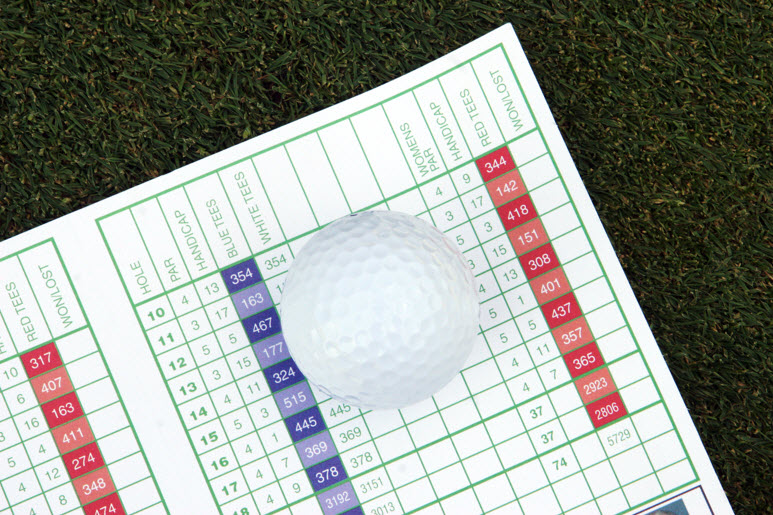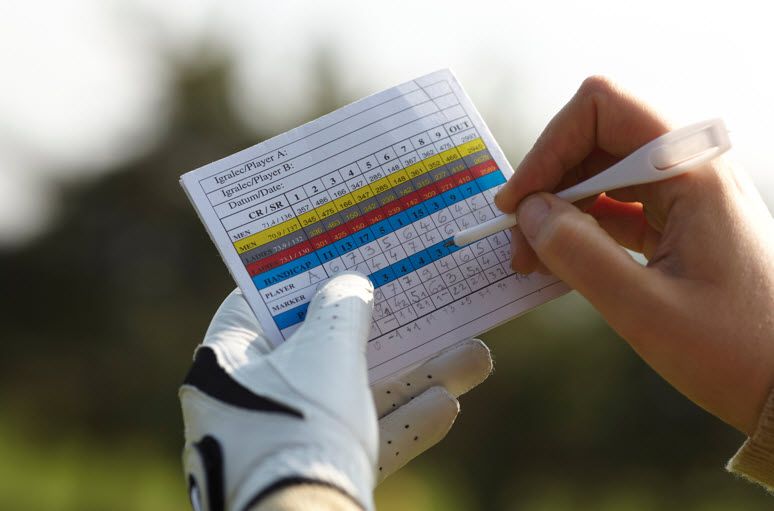Article Summary: How Do Golf Handicaps Work, A Guide For Beginners.
Just how DO Golf Handicaps work? Handicaps, if we’re being honest, are a downright mind-boggling Golf scoring system that are more tedious than anything else.
Countless beginners struggle to fully grasp the concept while those who don’t play golf know nothing about it and why it matters.
Despite this, there’s sadly no way around it. [no_toc]
How Do Golf Handicaps Work - A Beginners Guide
SO - that being said, let's get into it!
Why Do They Exist?
Handicaps are designed to give everyone a level playing field and any serious golfer, professional or otherwise, needs to work on his or her handicap score to improve.
In essence, having a handicap score is what separates the true players from the novices.
Despite being complicated, you don’t have to go back to math class to calculate your handicap properly.
The formula is fairly straightforward and can be picked up in a day with the right teachings.
That’s what we aim to do here.
In this article, I've laid out in simple terms the reason and formula for golf handicaps to help you, a beginner, learn how to calculate them yourself.
What Does Your Golf Handicap Mean? Why Is It Important?

Golf handicaps originally arose as a way for players to track improvement and play alongside similarly skilled opponents. Even today, they're a number that represents the golfer’s ability based on their previous golf round’s scores.
It is mainly used to compare your performances with other golf players:
- For men, your golf handicap is generally between 0 and 28
- For women, between 0 and 36
If you’re just starting out at golf, you don’t have to worry about things like handicaps.
They are mainly given to you once you join a golf club and start playing seriously at courses.
In the meantime, you should be more concerned with improving your overall skill.
Handicaps are essential in two ways:
- Firstly, they are a gauge of a player’s overall skill, allowing the player to know where to improve to attain a lower score.
- Secondly, your handicap is a must when a player wants to participate in tournament-style formats. Many tournaments format their play so that a player’s handicap is used to score a round.
This means that a low handicap is a great equalizer, allowing even less-than-experienced players to win thanks to their hard work at keeping the handicap low.
Generally, the lower the handicap, the more skilled the player.
How To Calculate Your Handicap?

This is importation, so pay attention! 🙂
When you’re ready, the first thing you need to do is keep score.
- For this, you will need another golfer friend to accompany you in a round of 18 holes.
- Both of you will write down the scores for each other and sign each other’s scorecards at the end of the round.
- To be valid, a card needs two signatures — your own and that of the person you’re playing with.
- That way, all scores are valid, and corruption is kept to a minimum.
Once you have your scores, it’s time to calculate.
The method below follows the new calculation methods implemented by the USGA in 2020.
Step 1: Change The Gross Scores Into An Adjusted Total Score
You will need to use the USGA’s ESC (equitable stroke control) to come up with your adjusted total score.
The adjusted total score is essentially a player's gross score, including any penalty strokes, adjusted for when:
The player exceeds their maximum hole score, A hole is not played, or a hole is started but the player does not hole out.
Use the ESC downwards while adjusting the individual 18-hole scores to create a golf handicap.
Based on the ESC, you are allotted a maximum amount of strokes to enter into a whole.
Course Handicap | Maximum Score |
9 or less | Double Bogey |
10-19 | 7 |
20-29 | 8 |
30-39 | 9 |
40 and Above | 10 |
Step 2: Calculate The Handicap Differential For Each Score And Select The Lowest
When trying to get your handicap differential, use this formula:

Let me break down the above formula:
- The course rating is simply the scores of a new golfer on a normal course under a normal playing condition.
- Slope rating is the rating of 113, it's not fixed though. It is simply for a course based on the standard difficulty.
You’ll have to know the difficulty rating of the course you’re playing beforehand.
Once you have the differentials, it’s time to select the ones you’ll average.
Since the lowest handicap is always the best, always select your lowest handicap differential.
Step 3: Calculating The Average Of The Selected Differentials
If you have 10 handicap differentials available, calculate the average for the lowest 3 Handicap Differentials.
For 15 Handicap Differentials calculate the average for the lowest 6.
Once you have at least 20 scores, always use the 10 best from the most recent 20 scores.
Assume you selected 10 of your best and lowest scores out of 20. Simply add all those scores together and divide them by 10.
What you’ll be left with is the average.
Step 4: Multiply By 96% To Get Your Handicap Index

Once you have the average of your lowest differentials, multiply it by the newly adjusted percentage of 96% or 0.96.
Once you’ve got your total, delete the numbers to the right by tenths. For example, if your handicap differential average is 13.196 after multiplication by 0.96, the truncated value will be 13.1. Do not round off your results as this is considered cheating.
The United States Golf Association states that the default maximum number from any handicap index in a golf match should be 40.4 for women and 36.4 for men if played on an 18-hole course.
Step 5: Calculate The Course Handicap
A course handicap is the number of strokes a player receives on a particular course. To attain this, simply use this formula:
Course handicap = Handicap Index x Slope Rating/113 + (Course Rating or Par)
Example:
Assume that your course handicap calculation is a 12.7 and the course slope is 115
Course Handicap = 12.7 x 115 / 113 = 12.92 = 12.9
From this, you can confidently say that your Course Handicap is 12.9.
How Do You Lower Your Golf Handicap?

Having a good handicap is essential in certain tournaments that only allow players of a particular range.
In the beginning, you’ll find that your handicap improves a lot as you better yourself.
Once you’re somewhat established, getting your handicap lower might take more time.
There are only 2 sure ways to improve your handicap:
Here's what they are
1.) Practicing Your Swing
Practice makes perfect and the only way you can ensure you have a great handicap score is by pushing yourself constantly.
The handicap is only as good as the player producing it after all.
Working on your swing, practicing alongside skilled players, and putting in the time and effort are the only ways you can get your handicap to improve. You might even want to consider some golf lessons from your local golf pro. There's no shame in that, even the pros have people giving them tips to improve their games!
2.) Ensure You Have The Right Equipment

Sometimes the only thing holding a player back is the right tools and equipment.
Though you don’t need the most expensive or flashy gear to play golf, investing in some good quality clubs can seriously improve your game — and your handicap by extension.
Note: The rules and formulas stated in this article follow the regulations set out by the World Handicap System. Until recently, many other golf associations around the world have their own rules, equations, and percentages.
Luckily, the USGA and The R&A, working with the various existing handicapping authorities, devised a new World Handicap System (WHS) which began to be introduced globally in 2020.
Looking for a new set of clubs?
- For Beginners, check out the Callaway Big Bertha Irons
- If you're looking for something better geared towards better players, check out the Taylormade P770 Irons or even the Titleist T100 Irons (though they're more geared towards pros).
In Conclusion…
Once you’re serious about playing or competing in golf, handicaps are essential for better or for worse.
Learning it might be tedious, especially if you just want to have fun, but it is necessary to ensure fairness.
Players with less training or experience have won tournaments thanks to their handicaps after all.
Even more so, it is a testament to just how much golf is an intellectual sport as it is a physical one.
With all that being said, many players get too caught up on handicaps, forgetting that golfing still requires skill and training more than it does numbers.
As a beginner, we would urge you to focus more on building muscle memory for your swings and getting the ball where you want it to.
These are highly more valuable traits than being able to keep track of someone else’s score.
Once you have these down, then getting your handicap is simply the natural next step.
And, because you’ve read this article and know how golf handicaps work, you’re probably gonna have an easier time calculating your own handicap than other new players will!

